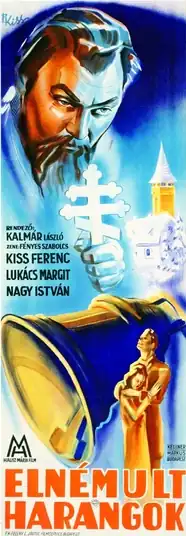| Silenced Bells | |
|---|---|
 | |
| Directed by | László Kalmár |
| Written by | Sándor Hunyady |
| Based on | Silenced Bells by Viktor Rákosi |
| Produced by | Mária Hausz |
| Starring | Margit Lukács Ferenc Kiss István Nagy |
| Cinematography | István Eiben |
| Edited by | Zoltán Kerényi |
| Music by | Szabolcs Fényes |
Production company | Hausz Mária Filmkölcsönzõ |
Release date | 27 February 1941 |
Running time | 97 minutes |
| Country | Hungary |
| Language | Hungarian |
Silenced Bells (Hungarian: Elnémult harangok) is a 1941 Hungarian drama film directed by László Kalmár and starring Margit Lukács, Ferenc Kiss and István Nagy.[1] It was shot at the Hunnia Studios in Budapest. The film's sets were designed by the art director Imre Sörés. It is based on a novel of the same title by Viktor Rákosi, which had previously been adapted into 1916 and 1922 silent versions.
Cast
- Margit Lukács as Florica
- Ferenc Kiss as Todorescu
- István Nagy as Simándy Pál református lelkész
- Géza Berczy as Fõispáni államtitkár
- Nándor Bihary as Cigányprímás
- László Földényi as Orosz gróf
- Zoltán Greguss as Radescu
- Lajos Gárday as Pásztor
- János Görbe as Pásztor
- Gyula id. Szabó as Kocsmáros
- József Juhász as Pásztor
- Lajos Kelemen as Pásztor
- Mária Keresztessy as Todorescu felesége
- Árpád Lehotay as Fõispán
- László Misoga as Pásztor
- Domokos Sala as Pásztor
- Marcsa Simon as Sári néni
- Lajos Sugár as Angol újságíró
- Dezsö Szalóky as öreg parasztember
- Gyula Szöreghy as Vendég a kolozsvári fogadóban
- Kató Timár as Todorescuék cselédje
- Sándor Tompa as Kurátor
- Gusztáv Vándory as Református püspök
References
- ↑ Judson & Rozenblit p.213
Bibliography
- Judson, Pieter and M. Rozenblit, Marsha L. (ed). Constructing Nationalities in East Central Europe. Berghahn Books, 2005.
- Juhász, István. Kincses magyar filmtár 1931-1944: az eredeti forgatókönyvből 1931 és 1944 között létrejött hazai mozgóképekről. Kráter, 2007.
- Rîpeanu, Bujor. (ed.) International Directory of Cinematographers, Set- and Costume Designers in Film: Hungary (from the beginnings to 1988). Saur, 1981.
External links
This article is issued from Wikipedia. The text is licensed under Creative Commons - Attribution - Sharealike. Additional terms may apply for the media files.